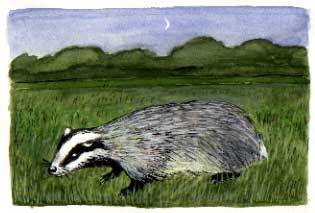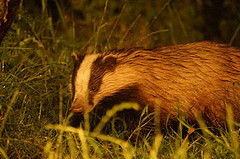Factsheet
Badgers
Badgers are iconic countryside mammals widespread throught UK, Ireland and parts of Europe
Overview
 Order: Carnivora
Order: Carnivora
Family: Mustelidae
Species: Meles meles (European Badger)
IUCN Red List Status: Least concern.
Distribution: widespread throughout most of Europe including Britain and Ireland; they are most common in the south and west; scarce in East Anglia, parts of Scotland, urban Midlands.
Habitat: deciduous woodland, farmland and some large urban gardens and coastal cliffs.
Life-span: up to about 15 years
Size: Male:- head and body up to 76cm (30in); tail 15cm (6in). Female smaller.
Population: A survey of badger dens was conducted across England and Wales between November 2011 and March 2013. The ‘estimated abundance of social groups’ was 71,600, an increase of 88% since the last study in 1985-1988.
Description: stocky grey body, short tail; distinctive black-and-white striped head with small white tipped ears.
Food: omnivore (both meat and plant eater); earthworms are the main food; also beetles, slugs, wasp grubs, frogs, young rabbits and mice, fruit, bluebell bulbs.
Badgers are one of the most popular and well-known British mammals. Some places have been named after them, such as Brockenhurst in Hampshire and Brockhall in Northamptonshire - brocc is an old English word for badger.
Badger Habits
Territory: badgers live underground in large burrow systems called setts. A sett is usually dug in sloping ground in a wood or copse bordering pastureland. Some setts have been used for over 100 years by generations of badgers and may have more than 40 entrances. The underground tunnels may be up to 30m long. Tunnels are on different levels, about 100cm from the surface. At the end of a tunnel is a chamber, used for sleeping or breeding. A badger community normally consists of several adult boars (males) and sows (females) together with one or two litters of cubs - up to 15 animals in total. A community's territory may be 90-120 acres in size.
 Daily life: badgers are nocturnal and emerge from their setts soon after dusk, sniffing the air for danger before going about their activities. They are very clean animals and always deposit their droppings in shallow pits some distance from the sett. Bedding material is also changed frequently. Straw, bracken, dry leaves etc. are gathered between the forepaws and the badger shuffles backwards to the sett entrance.
Daily life: badgers are nocturnal and emerge from their setts soon after dusk, sniffing the air for danger before going about their activities. They are very clean animals and always deposit their droppings in shallow pits some distance from the sett. Bedding material is also changed frequently. Straw, bracken, dry leaves etc. are gathered between the forepaws and the badger shuffles backwards to the sett entrance.
Near the sett there is usually a "scratching tree", engraved with sets of parallel claw marks. Sharpening claws keep them in good condition for digging.
Before going off to forage for food along well-used paths throughout their territory, badgers may spend some time around their sett. Half-grown cubs enjoy playing with each other, chasing, jumping and tumbling - the adults often join them. They like to groom each other too. Badgers in the same group recognise each other by scent; one badger "musks" another by backing onto it with its tail raised to secrete a strong-smelling liquid from a gland under its tail.
Winter: during the autumn, badgers eat as much as they can, laying down a lot of fat under the skin, increasing their weight by up to 6%. This helps them to survive the winter. They do not hibernate but spend the coldest weather sleeping in their setts, living mainly off their fat.
Breeding: badgers may mate in any month between February and October but the fertilised egg does not start developing until December. This is called delayed implantation. The cubs are born about eight weeks after implantation, from mid-January to mid-March. There are usually two or three cubs in a litter and to begin with they are blind and have silky, greyish-white fur. They remain underground until they are 8 weeks old and weaning starts at 12 weeks of age. Some cubs stay with the family group and others leave to find new territories. Females are ready to breed at 12-15 months, males take longer, usually maturing by the age of two.
Badgers and Humans
Disease: Although the occasional 'rogue' may develop a liking for poultry, on the whole badgers do more good than harm. However, some people have been at odds with badgers for many decades for a variety of reasons.
In the early 1970s some badgers, mainly in south-west England, were found to be infected with the bacteria that cause tuberculosis (TB) in cattle. The Ministry of Agriculture thought it was likely that badgers could transmit the disease to cattle; as a result thousands of setts were gassed to try and stamp out the disease. Tuberculosis is still affecting cattle in some areas, particularly in the south-west of England and in 2013 there were two pilot badger culls carried out in Somerset and Gloucestershire. According to a report by the Department for Environment, Food and Rural Affairs, the benefits of reducing disease in the Somerset cull area in 2014 are expected to be realised, and it is advised that culling should continue in 2015 and for at least one further year. The benefits of the cull in Gloucestershire may not be realised but should be continued in 2015 and possibly continued beyond 2017.
The culling of the badgers aims to reduce the disease which has been increasing throughout parts of the UK for many years. The latest information from The Department for Environment Food and Rural Affairs states that the costs of the first year of the two badger culls, including the pilot stage, were £6.3m. Badgers are a protected species and cannot be killed without special permission.
Many animal welfare organisations and animal lovers are against the idea of killing the badgers and scientists say that culling could even make the problem of disease worse not better.
Road traffic: Although both the badger and its sett are protected by law, this does not prevent the death of 40,000 badgers killed by road traffic every year. Badgers follow the same paths all their lives, so if a road is built across their path they will continue to use it. On some new roads where an established badger path is known to exist, special badger tunnels have been built underneath the road.
Illegal sport: An increasing threat to badgers is the illegal, extremely cruel 'sport' of badger-digging and baiting. Despite being made illegal is 1835 and still an offence under the Protection of Animals Act, the practice continues. Badgers are caught with the help of aggressive dogs, trained and encouraged to fight with the badgers, and kill them as a spectator sport for the badger-baiters. It is estimated that 10,000 badgers a year suffer at the hands of badger-diggers, particularly in Wales and the north of England.
Protecting the Badger
There are more than 70 badger groups around Britain. These groups survey the setts in their area and try to keep an eye on them, looking out for signs of interference. If you suspect that a sett is being disturbed by people, record any vehicle registration numbers and descriptions from a safe distance and contact the police or RSPCA.
Badger groups also co-operate with the Department of Transport who arrange for a tunnel to be constructed if a sett is proved to be in the line of a planned road.
If you would like to find out more about your local badger group, then visit the useful links on the next page.
Useful Links
If you would like to find out more about your local badger group, then visit:
The Badger Trust http://www.badger.org.uk/Content/Home.asp
The Wildlife Trusts http://www.wildlifetrusts.org/
Credits
Image: Badger by Cloudtail
Information sourced from:
Nature.com Scientific Reports (2013), Density and abundance of badger social groups in England and Wales in 2011-2013 [online], Available from: http://www.nature.com/srep/2014/140123/srep03809/full/srep03809.html [accessed 14/06/2015].
Department for Environment, Food and Rural Affairs (2014), Chief Veterinary Officer’s advice on outcome of year 2 of the badger culls [online], Available from: https://www.gov.uk/government/uploads/system/uploads/attachment_data/file/388699/cvoadvice.pdf [accessed 14/06/2015].
Department for Environment, Food and Rural Affairs (2014), REQUEST FOR INFORMATION: Badger Cull Costs [online] Available from: https://www.gov.uk/government/uploads/system/uploads/attachment_data/file/399021/RFI_6913_TRANSPARENCY_amended.pdf [accessed 14/06/2015]
 Order: Carnivora
Order: Carnivora
 Daily life: badgers are nocturnal and emerge from their setts soon after dusk, sniffing the air for danger before going about their activities. They are very clean animals and always deposit their droppings in shallow pits some distance from the sett. Bedding material is also changed frequently. Straw, bracken, dry leaves etc. are gathered between the forepaws and the badger shuffles backwards to the sett entrance.
Daily life: badgers are nocturnal and emerge from their setts soon after dusk, sniffing the air for danger before going about their activities. They are very clean animals and always deposit their droppings in shallow pits some distance from the sett. Bedding material is also changed frequently. Straw, bracken, dry leaves etc. are gathered between the forepaws and the badger shuffles backwards to the sett entrance.